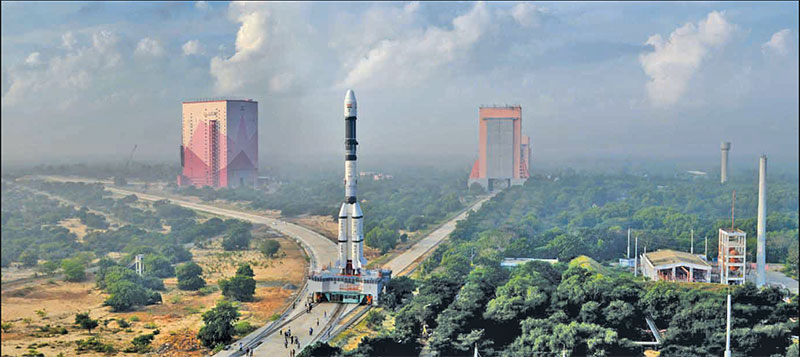Private enterprises can be involved more in contributing to India’s space technology
 Lt Gen. Rameshwar Yadav (retd)
Lt Gen. Rameshwar Yadav (retd)
There is an obvious euphoria in the country after Indian Space Research Organisation (ISRO) showcased world class technology to launch its Mars and Moon missions. The successful missions, and ISRO’s anti-satellite capabilities have catapulted India into the league of ‘space-faring’ nations. It goes to prove the technological prowess of Indian scientists and national structural strength to explore the space for human development and also war efforts whenever needed.
ISRO has proven its enviable technological capabilities and its contribution in taking the gross national power to the next level. Having achieved an optimal threshold, enlarging the scope of national space mission is a logical step to further national geo-political interests. It prompts us to gradually open up the space industry and make it inclusive to private enterprise for wider reach with primacy of in-house innovations for strategic reasons.
ISRO is mandated to handle planning, R&D, technology acquisition, fabrication, testing, and launching of space missions. It is also entrusted with the training of scientists and work force, HR, infrastructure, logistics and management issues. Whereas, looking at the capabilities of the aeronautical industry in private sector, a large percentage of R&D, manufacturing, logistics and management can easily be outsourced to them. It would leave ISRO to concentrate on building core competencies and execute space missions to enhance national strategic outreach. Yes, the core technologies and processes of strategic value certainly need appropriate secrecy cover confining to the folds of ISRO.
In the West the R&D is entrusted to multiple agencies as partners of the industry including strategic domain. Similarly, the private enterprise in India may also be involved in contributing toward space exploration so as to tap potential of larger scientist community and infuse more efficiency. Therefore, it would be a pragmatic idea that this field is thrown open to non-government R&D establishments, technical universities and individual scientists.
Such an approach would help in creating redundancies in our national power mechanism instead of relying only on single organisation such as the ISRO. The inclusion of private enterprise gets further highlighted as time is at premium due to ever increasing competition in the race for space. Moreover, the momentum achieved by the ISRO needs to be maintained, lest we miss out on the much-needed strategic edge of being a space power. In the proposed format, ISRO would continue as the central spine of national space mission with private enterprise as a support system, thereby maximising the national technological synergies.
The US is a pioneer in space technology with NASA as their government sponsored establishment. The US has always encouraged private enterprises to contribute to their national effort right from the beginning of their space explorations. Private companies like Space X, Blue Origin and Virgin Galactic have become increasingly important in American space exploration missions. The NASA is known to have paid USD6.8 billion to private companies to develop launch systems. They also have plans to send astronauts into space soon. It is due to the structural strength of private industry that a parallel space enterprise is thriving in the US providing almost all services on commercial terms.
As on date, the US, Russia, China, Germany, Japan, India and Brazil have proven space technology capabilities. Looking at the utility of space for economic and humanitarian purposes, more nations are likely to either join the space club, or look for space-oriented services. Therefore, a tremendous commercial scope exists in space-related services. In that, India with her proven space technology with comparatively low mission costs has a scope to acquire a large market share in the future.
ISRO has been launching satellites of other countries for quite some time, besides providing satellite imagery, remote sensing, communication and miscellaneous environmental science services; the latest being the launch of PSLV-C 47 that placed earth observation satellite Cartosat-3 along with 13 US nano satellites on 27 November 2019. As on date, ISRO has launched over 300 satellites for 33 nations which is a milestone in itself.
ISRO has an ongoing project, Indian Regional Navigational Satellite System (IRNSS), similar to GPS, which provides real-time positioning and timing services covering India and other areas within 1,500 km around it. It is also known as NAVIK navigational system. We need to harness and enhance the scope of similar satellite-based services on commercial basis for our economic expansion. It would result in higher national ‘strategic pull’ as such services are long-term engagements with positive political dividends. The private enterprise can be of immense utility in this field alongside ISRO as seen in the US model.

The intrusion in space for military purposes is becoming the new horizon of the hybrid warfare. It is, therefore, incumbent on India with hostile periphery to acquire technological edge to neutralise the inimical tendencies. While the primacy of economic development would remain as the mainstay of space policies, the military angle is equally important in the Indian context. India, accordingly, has plans of creating an aerospace command in her armed forces structure which would be functioning in close concert with ISRO. It obviously cannot be done by ISRO alone as it would warrant a well synergised national effort including structural competencies of the aerospace private industry also.
How do we as a nation harmonise the potential of the scientists and utilise their talent? The space is a strategic domain and would need higher political direction and concomitant inter-ministerial interface. Conceptually, it would require spelling out the national space strategy to provide the higher direction to all the institutions, agencies, industry and individuals. The technological objectives and concomitant research fields need to be worked out by a national regulating body with active participation by ISRO in concert with other space related organisations and experts. It would lead to division of work amongst all the ingredients of the entire structural make-up and synergy amongst the scientific community and the industry.
The policies and guidelines so arrived would require to be promulgated to the environment including the private players on ‘Need to Know’ basis. There may be ideating sessions, seminars and discussions amongst the scientific community and industry to work out the way ahead for optimal efficiency. While the private industry works under a free market environment, the space verticals would need optimal government support and incentives in the initial stages. Once the industry reaches a reasonably stable level, the government should switch to the role of a facilitator.
There is a reservoir of untapped technological and management talent waiting to be given an opportunity in the space industry. Indian scientists are known for their contribution in innovating cutting edge technologies including in space domain in other countries. Young scientists with similar DNA can do wonders provided they get suitable research environment and structural and financial support to pursue their projects. The phenomenon of start-ups has caught up in India in a big way in almost all the industrial fields.
It is a proven fact that the start-ups are doing wonders in the industry providing low cost alternate through creative use of technology. However, it is a road full of obstacles for the start-up entrepreneurs who are usually young technocrats and first-time business managers. The ideas of these young professionals would certainly add to the technological empowerment of the industry in a positive way. Apropos, there exists a tremendous potential and scope of mind harvesting of these young scientists with their innovative streak to fill up the technology deficit in the aerospace industry also.
The production process involves technologies, operating systems, manufacturing procedures, assembly lines, proof testing, packaging, transportation, marketing and sales, repair and maintenance and hosts of other business parameters etc. The start-ups can contribute by innovating the technologies and processes for developing ancillary units and services to support ISRO missions and the private sector engaged in aerospace domain. These start-ups would add one more layer right at the bottom to the manufacturing hierarchy. Since they operate outside the confines of structured organisations, they would have an access to all the levels breaking the linearity of the structured processes as practiced so far. Bangalore is the hub wherein large number of space centric start-ups have come up in last one decade who are proving to be of great utility to ISRO and the emerging private aerospace industry.
Prominent amongst these are Exseed Space, Dhruva Space, Earth2orbit (E2O), Team Indus, ARDL of Indian Institute of Science, Xovion, Bellatrix Aerospace and few others. Exseed Space is working towards setting up India’s first contract satellite manufacturing facility. Once operational, the facility will cater to the growing global demands of manufacturing Cubesats, Nano-sats & Micro-sats. They are also working on communication installations in the space. It is the first Indian company which has already placed a satellite in the space. E2O products and services include satellite and launch services, human space systems, robotic systems, infrastructure and aerospace consulting. Team Indus is working towards developing and launching their lunar rover mission. There are a number of start-ups which are trying to fathom the technological barriers and create a place for themselves in the aerospace industry.
The government as part of ‘Make in India’ has launched a scheme wherein up to 80 per cent of the R&D costs would be compensated provided the prototype comes up to the desired level of satisfaction. Rs 500 crore have been earmarked as per a recent media report for providing financial assistance to the start-ups and individual scientists. The government may also help start-ups by permitting use of government research laboratories, ranges, testing equipment and quality assurance facilities etc. Similarly, the private industries may also be given incentives to provide their R&D facilities to the young scientists and professionals. The universities and technology institutions like IITs may invite and involve the start-ups in their space research projects with appropriate funding. The private industry may be mandated to include financial assistance to the start-ups out of their CSR funds as it generates employment.
As per media reports, ISRO has planned to set up 12 centres to promote space related R&D which would include six incubation nodes and six research centres. These centres would help the start-ups to develop prototypes of components and processes for the space systems. Such an incentive to the start-ups to provide technology solutions at comparatively lower costs has lot of business sense. The Defence Research and Development Organisation (DRDO), Defence Public Sector Undertakings (DPSUs) involved in Avionics, Missiles, & Rockets, universities and private industry may also be prompted to establish similar research and training centres for aerospace applications.
It is heartening to observe that there is a section of young scientists and engineers who have taken the plunge in the field of space technology in small groups as start-ups. One can see these youngsters flooding the discussions and seminars across the country trying to make their presence felt seeking structural support from the powers to be. Given appropriate incentives and encouragement, the start-ups in space technology have the potential to reframe the cliché ‘Sky is the limit’ to ‘Space is not the limit’ for them. They surely have ‘fire in the belly and passion in heart’ to do something big in their pursuit of exploring the limitless vistas of deep space. Let’s encourage and involve them in our national space mission and harness their potential to take our strategic reach to the next higher level.
(The writer is former director general Infantry, Indian Army)

